Appalachian Trail State Profile: New Hampshire
Somewhere in the vast green forest of New Hampshire, the Appalachian Trail steals across a small stream called Oliverian Brook, which snakes through a notch of the same name. This place is significant, and not just because it’s hard to get across the creek without getting your feet wet. Oliverian Notch is the symbolic boundary line between two divergent worlds.
To the south lie some 1,800 miles of the kind of wooded, hilly terrain that any East Coast hiker will be familiar with. It’s beautiful, dramatic, and doesn’t always get the credit it deserves. North of this notch, the trail becomes something altogether different.

Photo: Maggie Slepian
Just north, Mount Moosilauke stands sentinel between familiar Appalachian terrain and the rugged crags of New Hampshire’s infamous White Mountains. In the Whites, the weather is wild, the going is tough, and the traverses are truly epic. Northbound hikers like to say that 20% of the miles and 80% of the effort still lie ahead.
While New Hampshire might be one of the toughest sections of the trail, it also ranks among hikers’ favorites. This unforgettable section inspires equal measures of fear and fondness in the hearts of Type II fun-lovers everywhere.
Terrain and Trail Conditions

This hike isn’t for the faint of heart: do not underestimate the trials and perils of these mountains. Among the obstacles you’ll contend with are rocky tread and steep, steep, steep terrain. Did we mention that it can be steep? Oftentimes, you’ll need to stow your trekking poles in order to free your hands for precarious scrambles. It’s common for the trail to lead right to the base of a literal cliff that hikers must scale in order to keep following the white blazes, which resume their normal course some 15 feet above as though this is all entirely normal. Progress in these parts is slow, and seasoned thru-hikers can find their daily mileage cut nearly in half.
On top of the challenging terrain, hikers in the White Mountains need to be prepared for all sorts of weather. Conditions can change on a dime from hot sun to cold wind and hail. Snow is possible at any time of year. Even in summer, you should be equipped to deal with cold and high winds. At the same time, be prepared for heat and sun exposure on the section’s many exposed traverses. Sunburn can be a real issue in this area—timberline occurs around 4,500 feet in the Whites, and you’ll spend plenty of time above it.
Camping Regulations
Dispersed camping is allowed in most places in the Whites, with limitations. Camping is prohibited above treeline; within a quarter-mile of roads, huts, campsites, or streams; and within 200 feet of any trail. Be sure to carry cash, because most campsites in the area are pay-to-stay. Thru-hiker passes are available for purchase at any AMC campsite for $10 (this also covers your camp fee for the night). These passes ought to pay for themselves quickly in the form of 50% discounts on all subsequent stays at AMC campsites for the next two weeks, as well as free and discounted treats from hut cafeterias and discounted merchandise.
Unless you’re comfortable planning your hike well in advance, it would be unwise to count on the huts for accommodation. Reservations are virtually impossible to get during the busy tourist season and are quite expensive. All AMC huts allow at least two thru-hikers to sleep on their floor each night in exchange for a few hours of work around the facility. Lakes of the Clouds Hut has four work-for-stay slots per night, plus six paid bunks in The Dungeon. These work-for-stay arrangements are popular with thru-hikers and are a great way to experience hut culture. They’re available each afternoon on a first-come, first-served basis.
New Hampshire Highlights
1,749.9: Hanover
Hanover welcomes thru-hikers to New Hampshire with quintessential trail town hospitality. Trail angels keep an extensive list among themselves that details the contact information of townspeople willing to help hikers. The bakery and pizzeria downtown offer thru-hikers a free baked good and a free slice, respectively, and bars and eateries abound in this college town. Be sure to get your picture at the Vermont-New Hampshire state line on the bridge over the Connecticut River. Possible town activities include touring Dartmouth’s stately campus and eating your weight in bread at Molly’s Restaurant & Bar. If your wallet’s feeling a little too fat, pick up a highbrow resupply at the Hanover Co-Op on the north end of town. You can also get a bus to or from Boston via Dartmouth Coach.
1,773.1-2: Smarts Mountain
When the subject of New Hampshire comes up, we all love to wax eloquent about the White Mountains. But we’d be remiss in not talking about the 40 lower elevation miles of New Hampshire between Hanover and Moosilauke, which have their own share of technical challenges and triumphant summits. Smarts Mountain, with its scenic fire tower and rocky outcrops, holds its own in the highlight reel next to the more famous peaks of the Whites.
1,798.8: Mount Moosilauke

Steps help make the steep and slick Beaver Brook Trail on the northern slope of Moosilauke more manageable.
Mount Moosilauke is the southern gateway to the Whites. The south side of Moosilauke is longer but more gradual than the steep and slippery north side. Therefore, many northbound hikers choose to go southbound over Moosilauke. This saves their lungs from a longer climb and their knees from a steeper descent. Hiker’s Welcome Hostel in Glencliff does a brisk business in facilitating this short-term flip.
Up top, hikers will break treeline and enjoy 360-degree views across New Hampshire, New York, and Vermont. Giant cairns mark the way to the summit and are big enough to remain visible even in fog and heavy snowpack. The wind can be brutal up on the bald summit of Moosilauke, but fortunately, the ruins of an old inn stand at the top and make an excellent windbreak.
1,815.9: Lonesome Lake Hut
All the huts in the Whites are amazing, but Lonesome Lake Hut is the very first one a northbound hiker will encounter, so it gets a special shout-out. Also, the eponymous Lonesome Lake itself is a great swimming hole, so, you know. There’s that.
The Appalachian Mountain Club operates numerous huts in the White Mountains (the Randolph Mountain Club has a few, too). They’re charming to look at, can offer a welcome break from inclement and dangerous weather, and, importantly, they’re full of food. If you’re lucky, you may get some discounted goodies or a plate of free leftovers that staff will otherwise have to pack out as garbage. If you get a chance, give a shout-out to the friendly “croo” members who keep the huts up and running.
1,824.3: Franconia Ridge
This two-mile traverse above treeline follows the narrow spine of Franconia Ridge from Little Haystack Mountain over Mount Lincoln and finally Mount Lafayette. The trail winds away along the sharp ridgeline like a ribbon, with the mountain sloping steeply away on either side. Be prepared to get your blood pumping on this tough but memorable stretch. It’s all worth it: Franconia Ridge is widely considered to be one of the premier hikes in the White Mountains.
1,846.3-1,872.6: Presidential Traverse
If you thought two miles above treeline at Franconia Ridge was a lot, wait until you encounter the Presidential Traverse. From Crawford Notch, you’ll summit Mount Pierce and then climb above treeline on the slopes of Mount Eisenhower. You’ll remain above treeline for more than 10 miles until you’ve gotten past boulder-strewn Mount Madison, crossing five additional Presidential peaks along the way. The extended trek above treeline affords stunning views in every direction and feels otherworldly. That being said, the exposure can also make the traverse very dangerous in inclement weather.
Since camping above timberline is prohibited, some hikers break up the traverse by staying at Lakes of the Clouds Hut at mile 1,857.6. Four work-for-stay slots are available to thru-hikers. An additional six hikers can bunk in the hut’s dank emergency shelter (The Dungeon) for $10 per head.
1,859.1: Mount Washington

Hikers sometimes have to wait in line to get their pictures taken with the Mount Washington summit sign.
Mount Washington is the crown jewel of the Presidential Traverse. Standing 6,288 feet above sea level, it’s the highest peak in the Whites and the second-highest on the AT. At the summit, triumphant hikers mingle with tourists freshly unloaded from cars, buses, and cog rail cars. The high level of accessibility at the summit means it can be very crowded. That means that during tourist season, an early arrival may be advisable (especially if you want your picture next to the summit sign). Just north of the summit at mile 1,859.5, you’ll cross the tracks of the cog rail. If you’re lucky, you might see one of the old-timey locomotives laboring up to the summit or clattering its way down to the base.
Adding to the excitement, the weather on top of Mount Washington can be notoriously horrible. It quite literally boasts itself as “home of the world’s worst weather,” so if conditions are bad, don’t hesitate to turn back and tackle the mountain another day.
1,872.6: Pinkham Notch Breakfast
What better way to end (or begin!) a Presidential Traverse than with an all-you-can-eat breakfast at Joe Dodge Lodge? The answer is: there is no better way. The awe-inspiring traverse might fill up your heart and soul, but the lodge stands ready to fill your belly, too (between 6 and 9 a.m.). Private rooms and bunks are available at the notch. You can also hitch into the town of Gorham for even more treats and lodging operations. The AMC operates Joe Dodge and the adjoining Pinkham Notch Visitors Center.
New Hampshire Dispatches
More From This Series
All mileages taken from The 2019 AT Northbound Guide, by David “AWOL” Miller
This website contains affiliate links, which means The Trek may receive a percentage of any product or service you purchase using the links in the articles or advertisements. The buyer pays the same price as they would otherwise, and your purchase helps to support The Trek's ongoing goal to serve you quality backpacking advice and information. Thanks for your support!
To learn more, please visit the About This Site page.

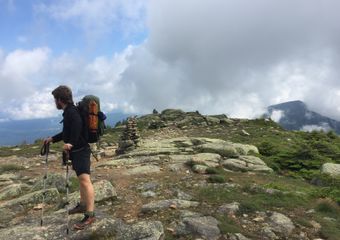




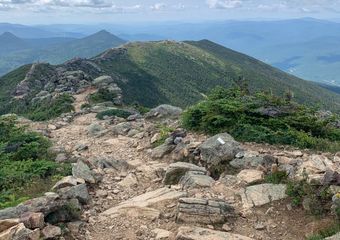
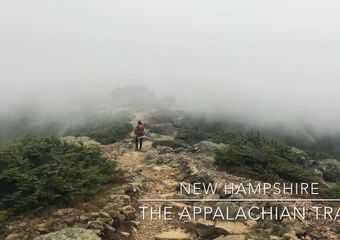
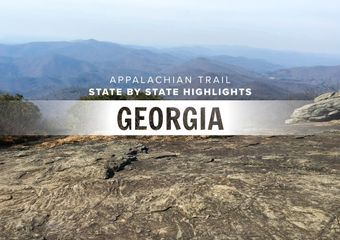
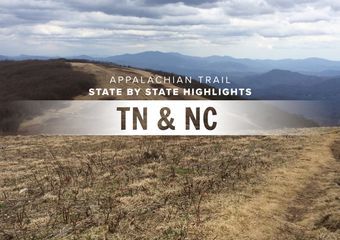

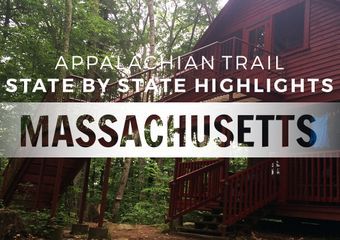
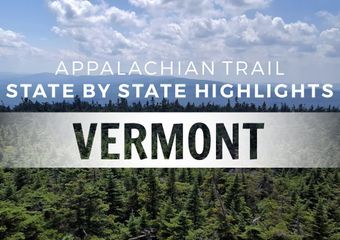

Comments 3
Randolf Mountain Club, Not Roanoke, I’m pretty sure.
Randolph it is. Now I’m going to see if there is a Roanoke someplace!
Corrected-thanks both of you for catching this! Of course, that was just a test to see who’s paying attention 😉